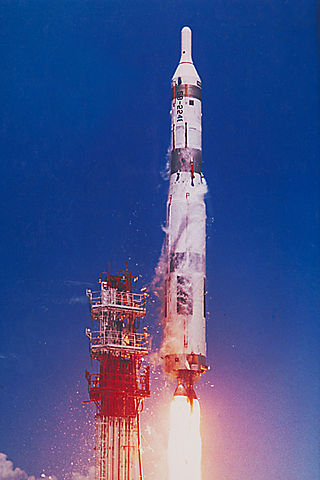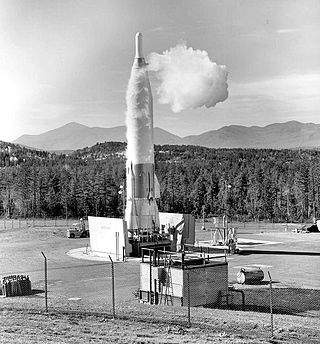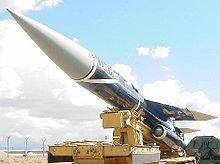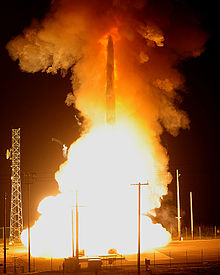
The LGM-30 Minuteman is an American land-based intercontinental ballistic missile (ICBM) in service with the Air Force Global Strike Command. As of 2024, the LGM-30G is the only land-based ICBM in service in the United States and represents the land leg of the U.S. nuclear triad, along with the Trident II submarine-launched ballistic missile (SLBM) and nuclear weapons carried by long-range strategic bombers.

Vandenberg Space Force Base, previously Vandenberg Air Force Base, is a United States Space Force Base in Santa Barbara County, California. Established in 1941, Vandenberg Space Force Base is a space launch base, launching spacecraft from the Western Range, and also performs missile testing. The United States Space Force's Space Launch Delta 30 serves as the host delta for the base, equivalent to an Air Force air base wing. In addition to its military space launch mission, Vandenberg Space Force Base also hosts space launches for civil and commercial space entities, such as NASA and SpaceX.

The 526th Intercontinental Ballistic Missile Systems Group is an inactive United States Air Force (USAF) unit. It was last located at Hill AFB, Utah, where it was inactivated in 2010. The group was first activated during World War II to conduct anti-submarine warfare in the Caribbean and off the Atlantic seaboard of Georgia and Florida. It was again active during the Cold War as an Atlas missile wing. Its final period of active service was as a systems and sustainment organization for USAF missile systems.

The 564th Missile Squadron is an inactive United States Air Force unit. It was last assigned to the 341st Operations Group at Malmstrom Air Force Base, Montana, where it was inactivated on 19 August 2008.

The 10th Missile Squadron is a United States Air Force unit. It is assigned to the 341st Operations Group, stationed at Malmstrom Air Force Base, Montana. The squadron is equipped with the LGM-30G Minuteman III Intercontinental ballistic missile, with a mission of nuclear deterrence.

The 66th Missile Squadron is an inactive United States Air Force unit. It was last assigned to the 44th Operations Group, stationed at Ellsworth Air Force Base, South Dakota. The 66th was equipped with the LGM-30F Minuteman II Intercontinental ballistic missile, with a mission of nuclear deterrence. With the end of the Cold War, the 66th was inactivated on 1 September 1993. Number of flights 100

The 821st Strategic Aerospace Division is an inactive United States Air Force organization. Its last assignment was with Fifteenth Air Force at Ellsworth Air Force Base, South Dakota, where it was inactivated on 30 June 1971.
The SM-68 Titan was the designation of two intercontinental ballistic missiles developed for the United States Air Force. The Titan I and Titan II missiles were operational between 1962 and 1987 during the Cold War. These missiles, particularly the Titan II, were the basis of the Titan family of space launch vehicles.

The 319th Missile Squadron is a United States Air Force unit assigned to the 90th Operations Group at Francis E. Warren Air Force Base, Wyoming. The squadron is equipped with the LGM-30G Minuteman III intercontinental ballistic missile, with a mission of nuclear deterrence. It is the flagship squadron of the 90th Missile Wing.

The 320th Missile Squadron is a United States Air Force unit. It is assigned to the 90th Operations Group, stationed at F.E. Warren AFB, Wyoming. The 320 MS is equipped with the LGM-30G Minuteman III Intercontinental ballistic missile (ICBM), with a mission of nuclear deterrence.

The 321st Missile Squadron is a United States Air Force unit. It is assigned to the 90th Operations Group, stationed at Francis E. Warren Air Force Base, Wyoming. The squadron is equipped with the LGM-30G Minuteman III Intercontinental ballistic missile (ICBM). Their mission is to operate safe and secure nuclear weapons, maintain mission ready facilities, and on order destroy OPLAN assigned targets.

The 490th Missile Squadron is a United States Air Force unit. It is assigned to the 341st Operations Group, stationed at Malmstrom AFB, Montana. The 490 MS is equipped with the LGM-30G Minuteman III Intercontinental ballistic missile, with a mission of nuclear deterrence.

The 13th Strategic Missile Division is an inactive United States Air Force unit. Its last assignment was with Fifteenth Air Force, based at Francis E. Warren Air Force Base, Wyoming. It was inactivated on 2 July 1966.

The 850th Strategic Missile Squadron is an inactive United States Air Force unit. It was last assigned to the 44th Strategic Missile Wing at Ellsworth Air Force Base, South Dakota, where it was inactivated on 25 March 1965. The squadron was first activated in 1943 as the 850th Bombardment Squadron. After training in the United States, it deployed to the European Theater of Operations and participated in the strategic bombing campaign against Germany. Following V-E Day, the squadron returned to the United States, where it was inactivated in November 1945.

The 68th Missile Squadron is an inactive United States Air Force unit. It was last assigned to the 44th Operations Group, stationed at Ellsworth AFB, South Dakota.

The 556th Strategic Missile Squadron is an inactive United States Air Force unit. It was last assigned to the 820th Strategic Aerospace Division at Plattsburgh Air Force Base, New York, where it was inactivated in 1965 with the withdrawal of the Atlas missile from operations.

The United States Air Force's 394th Strategic Missile Squadron was an intercontinental ballistic missile that operated the LGM-30 Minuteman and LGM-25C Titan II missiles at Vandenberg Air Force Base, California.

The 6555th Aerospace Test Group is an inactive United States Air Force unit. It was last assigned to the Eastern Space and Missile Center and stationed at Patrick Air Force Base, Florida. It was inactivated on 1 October 1990.

The 90th Missile Wing is a component of Twentieth Air Force, stationed at Francis E. Warren Air Force Base and equipped with LGM-30G Minuteman III Missiles. It has served at Warren as a component of Strategic Air Command, Air Combat Command, Air Force Space Command and Air Force Global Strike Command since 1963.






















